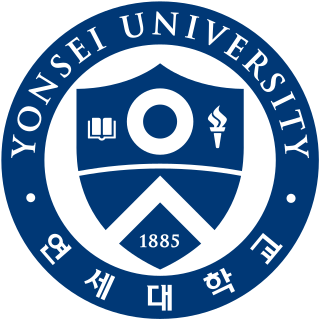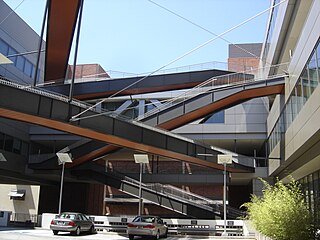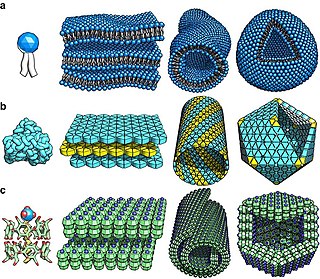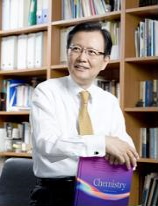
Daejeon is South Korea's fifth-largest metropolis. Daejeon had a population of over 1.5 million in 2010. Located in the central region of South Korea, Daejeon serves as a hub of transportation and is at the crossroads of major transport routes. The capital Seoul is about 50 minutes away by KTX high-speed train.

Yonsei University is a private research university in Seoul, South Korea. It is one of Korea's three SKY universities, a group of universities widely regarded as the most prestigious in the country. Yonsei was established in 1885 and is one of the oldest universities in South Korea.

The Korea Institute of Science and Technology is a multi-disciplinary research institute located in Seoul, South Korea. Founded in 1966, it was the first multi-disciplinary scientific research institute in Korea and has contributed significantly to the economic development of the country, particularly during the years of accelerated growth in the 1970s and 1980s. It has a research staff of over 1,800 research scientists, visiting scientists, fellows and trainees, and foreign scientists involved in basic research in various fields of science and technology.

Jeonbuk National University is a national research university founded in 1947, located in Jeonju, Republic of Korea. As the flagship national university for the Jeollabuk-do province, Jeonbuk National University has been ranked 501–550th in the world by QS Top Universities Ranking in 2016.
The Nanosystems Initiative Munich (NIM) is a German research cluster in the field of nano sciences. It is one of the excellence clusters being funded within the German Excellence Initiative of the Deutsche Forschungsgemeinschaft.

The California NanoSystems Institute (CNSI) is an integrated research center operating jointly at UCLA and UC Santa Barbara. Its missions are to foster interdisciplinary collaborations for discoveries in nanosystems and nanotechnology; train the next generation of scientists, educators and technology leaders; and facilitate partnerships with industry, fueling economic development and the social well-being of California, the United States and the world.

National Institute for Materials Science is an Independent Administrative Institution and one of the largest scientific research centers in Japan.

Nanoarchitectonics is a technology allowing to arrange nano-sized structural units, usually a group of atoms or molecules, in an intended configuration. It employs two major processes: nano-creation and nano-organization. Nano-organization involves re-arrangement of the structural units in a desired pattern, while nano-creation is synthesis of new materials that do not exist in nature. For example, by peeling atomic sheets off graphite slab, a novel nano-material graphene can be obtained, which has very different properties from graphite.
The Swiss Federal Laboratories for Materials Science and Technology is an interdisciplinary Swiss research institute for applied materials sciences and technology. As part of the Swiss Federal Institutes of Technology Domain, it is an institution of the Swiss federation. For most of the period since its foundation in 1880, it concentrated on classical materials testing. Since the late 1980s it has developed into a modern research and development institute.
Katsunori Wakabayashi is a physicist at the International Center for Materials Nanoarchitectonics (MANA), National Institute for Materials Science (NIMS), Japan. He is an authority and leading researcher in nanotechnology in the area of energy states of single wall carbon nanotubes (SWCN). His research is notable for the edge effects of the nanographene materials, which is a part of the single layer graphene. He obtained his Ph.D. in 2000 from University of Tsukuba in Japan. From 2000 to 2009 he was an assistant professor at Department of Quantum Matter in Hiroshima University, Japan. From 2009, he is an Independent Scientist at International Center for Materials Nanoarchitectonics (WPI-MANA), National Institute for Materials Science (NIMS) in Tsukuba, Japan. Beside the above primary research position, he was a visiting scholar at ETH-Zurich, Switzerland from 2003 to 2005, also had a concurrent position as PRESTO researcher in Japan Science and Technology Agency (JST).

Yeon Han-woong is a South Korean physicist. A tenured professor at POSTECH, he has led several research centers for the university and from 2013 in collaboration with the Institute for Basic Science. He is a Fellow of the American Physical Society and has served as vice chairman of the Korean government's first science and technology advisory group. With more than 300 publications to his name, his research has been cited over 5,000 times giving him an h-index of 40 and i10-index of 125.
Cheon Jinwoo is a South Korean chemist. He is the H.G. Underwood Professor at Yonsei University, Seoul, South Korea and the Director of Center for Nanomedicine, Institute for Basic Science (IBS). He is one of the leading chemists in inorganic materials chemistry. Dr. Cheon and his group carried out studies of chemical principles for the preparation of complex inorganic materials. As a pioneer in nanomedicine, he integrated nanomaterials and medicine. Dr. Cheon is a Senior Editor of Accounts of Chemical Research and an editorial advisory board member of Journal of Materials Chemistry, Nano Letters and Materials Horizons.

Choy Jin-ho is a South Korean scientist. He was a professor in the department of chemistry at Seoul National University from 1981 to 2004, and thereafter a distinguished professor and director of the Center for Intelligent Nano-Bio Materials (CINBM) at Ewha Womans University.

Shin Sung-chul is a South Korean physicist and the 16th president of KAIST. Shin was the first president of DGIST since it changed its form from a research institute to a university in 2011. His main research areas as a scientist are spintronics and nanomagnetism. As of June 2014, Shin is the founding president of DGIST university, Fellow Professor of University of Ulsan, a member of Presidential Advisory Council on Science & Technology (PACST), the chair of Committee for Future Strategy, PACST, and a Fellow of the American Physical Society(APS).

Robot Research Initiative (RRI) is a research institute dedicated to advanced robotics research. It is an affiliated organization of Chonnam National University in Gwangju, Republic of Korea. Prof. Jong Oh Park moved from the Korea Institute of Science and Technology to Chonnam National University in early 2005 and established RRI in March 2008, where he is still actively in charge. RRI is currently a leading institute in the medical robotics field, especially in the area of biomedical micro/nano robotics. RRI is one of the largest institutions among university robotics laboratories in Korea and competes globally.

Ajayan Vinu is a material scientist. He is currently the Global Innovation Chair Professor for Advanced Nanomaterials and the director of Global Innovative Centre for Advanced Nanomaterials (GICAN), The University of Newcastle since October 2017 which houses more than 40 researchers including PhD students and staff. Before moving to the University of Newcastle, he was a professor of Nanomaterials at the University of South Australia from 2015-2017. and also worked at the University of Queensland as a Professor and ARC Future Fellow from 2011-2015. He is well known in the field of mesoporous carbon nitride and was the first one to introduce porosity in carbon nitride materials which find applications in different areas of research including catalysis, energy storage and conversion and carbon dioxide capture, and photocatalytic water splitting for hydrogen generation.
Murali Sastry is an Indian material chemist, nanomaterial scientist and the chief executive officer of IITB-Monash Research Academy. He is a former chief scientist and Tata Chemicals and a former senior scientist at National Chemical Laboratory. He is known for his studies on surfaces, films and materials chemistry and is an elected fellow of Maharashtra Academy of Sciences and the Indian Academy of Sciences The Council of Scientific and Industrial Research, the apex agency of the Government of India for scientific research, awarded him the Shanti Swarup Bhatnagar Prize for Science and Technology, one of the highest Indian science awards, in 2002, for his contributions to chemical sciences.

Katsuhiko Ariga is a Japanese chemist specializing in nanotechnology and self-assembly. He was educated at the Tokyo Institute of Technology, where he defended his PhD in 1990 and later worked as assistant professor. Since 2004 he carries out research at the National Institute for Materials Science, and teaches at the University of Tokyo, where he is a full professor. Ariga is a Fellow of the Royal Society of Chemistry (2013) and an editor of the journal Science and Technology of Advanced Materials.












